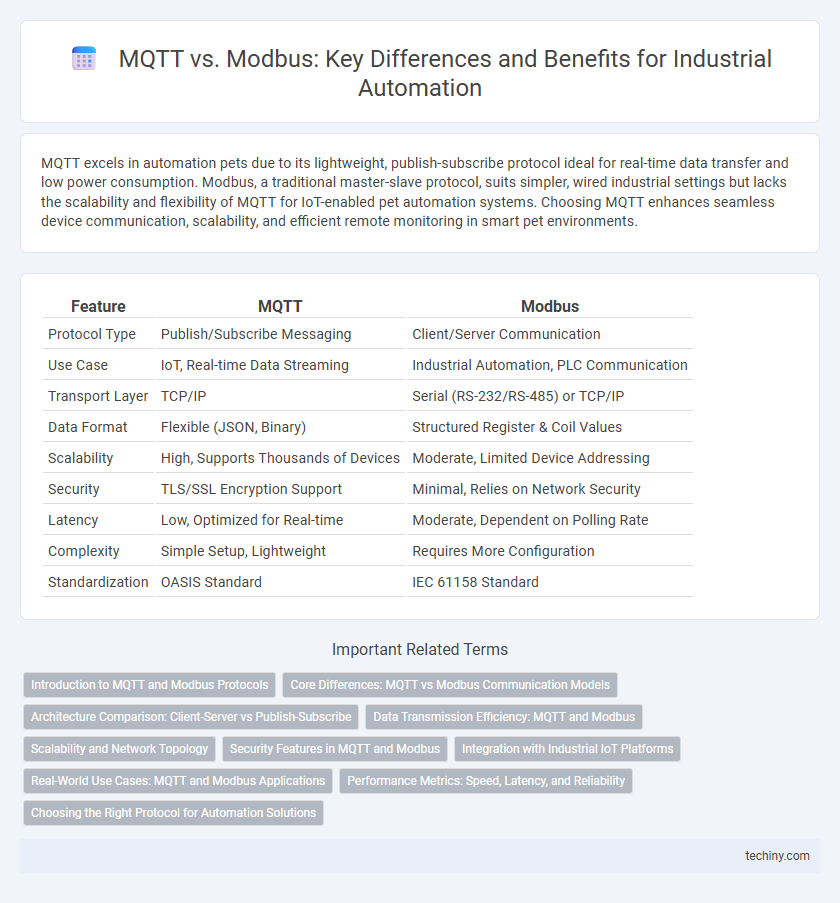MQTT excels in automation pets due to its lightweight, publish-subscribe protocol ideal for real-time data transfer and low power consumption. Modbus, a traditional master-slave protocol, suits simpler, wired industrial settings but lacks the scalability and flexibility of MQTT for IoT-enabled pet automation systems. Choosing MQTT enhances seamless device communication, scalability, and efficient remote monitoring in smart pet environments.
Table of Comparison
| Feature | MQTT | Modbus |
|---|---|---|
| Protocol Type | Publish/Subscribe Messaging | Client/Server Communication |
| Use Case | IoT, Real-time Data Streaming | Industrial Automation, PLC Communication |
| Transport Layer | TCP/IP | Serial (RS-232/RS-485) or TCP/IP |
| Data Format | Flexible (JSON, Binary) | Structured Register & Coil Values |
| Scalability | High, Supports Thousands of Devices | Moderate, Limited Device Addressing |
| Security | TLS/SSL Encryption Support | Minimal, Relies on Network Security |
| Latency | Low, Optimized for Real-time | Moderate, Dependent on Polling Rate |
| Complexity | Simple Setup, Lightweight | Requires More Configuration |
| Standardization | OASIS Standard | IEC 61158 Standard |
Introduction to MQTT and Modbus Protocols
MQTT is a lightweight, publish-subscribe messaging protocol designed for efficient communication in IoT and automation systems, ensuring low bandwidth and reliable data transfer. Modbus, a serial communication protocol, facilitates master-slave communication primarily in industrial automation for monitoring and controlling devices like PLCs and sensors. Both protocols serve distinct roles, with MQTT excelling in real-time data exchange over IP networks, while Modbus remains a standard for legacy and wired field device communication.
Core Differences: MQTT vs Modbus Communication Models
MQTT uses a publish-subscribe communication model that enables asynchronous, event-driven messaging over TCP/IP, ideal for IoT applications requiring scalable and efficient data distribution. Modbus relies on a master-slave communication model, functioning synchronously with direct request-response exchanges over serial or TCP/IP networks, suited for industrial automation with simple, deterministic control. The core difference lies in MQTT's decoupled and flexible architecture versus Modbus's straightforward and synchronous protocol design.
Architecture Comparison: Client-Server vs Publish-Subscribe
MQTT employs a publish-subscribe architecture, enabling devices to communicate asynchronously through a broker, which enhances scalability and decouples data producers from consumers. In contrast, Modbus follows a client-server model with direct, synchronous communication between a master device and multiple slave devices, resulting in a tightly coupled network. The broker-centric design of MQTT supports dynamic and distributed automation environments, while Modbus's architecture suits simpler, real-time control systems with predictable device interactions.
Data Transmission Efficiency: MQTT and Modbus
MQTT excels in data transmission efficiency by utilizing a lightweight publish-subscribe protocol optimized for low-bandwidth, high-latency networks, making it ideal for IoT environments. Modbus, a request-response protocol traditionally used in industrial automation, transmits data in a more rigid, periodic manner, which can result in higher overhead and latency. Consequently, MQTT offers superior scalability and faster real-time data exchange compared to Modbus, especially in distributed automation systems.
Scalability and Network Topology
MQTT offers superior scalability over Modbus due to its lightweight publish-subscribe architecture, enabling efficient communication across large, distributed networks with numerous devices. Modbus relies on a master-slave topology, limiting scalability and making it less suited for complex network expansions. MQTT's flexible broker-based network topology supports dynamic device addition and improved message routing, ideal for IoT and large-scale automation systems.
Security Features in MQTT and Modbus
MQTT offers enhanced security features such as SSL/TLS encryption, client authentication, and access control lists (ACLs), ensuring secure message transmission in automation systems. In contrast, Modbus lacks native encryption and relies heavily on external security measures, making it more vulnerable to interception and unauthorized access. The growing adoption of MQTT in industrial automation is driven by its robust security protocols, which address critical concerns absent in traditional Modbus implementations.
Integration with Industrial IoT Platforms
MQTT offers seamless integration with Industrial IoT platforms through lightweight, publish-subscribe messaging ideal for real-time data exchange and scalability across distributed systems. Modbus, primarily designed for direct device communication, often requires protocol gateways or converters to connect with modern IoT ecosystems, limiting its native interoperability. Industrial environments favor MQTT for its compatibility with cloud services, edge computing, and analytics tools, enhancing data accessibility and system responsiveness.
Real-World Use Cases: MQTT and Modbus Applications
MQTT excels in IoT environments for real-time data transmission between low-bandwidth devices, commonly used in smart homes, agriculture monitoring, and industrial automation with cloud integration. Modbus remains the standard in legacy industrial settings, facilitating reliable communication between PLCs, sensors, and SCADA systems in manufacturing plants and energy grids. Combining MQTT and Modbus enables seamless data flow from field devices to cloud platforms, optimizing predictive maintenance and operational efficiency.
Performance Metrics: Speed, Latency, and Reliability
MQTT outperforms Modbus in speed and latency due to its lightweight protocol design, enabling rapid message transmission ideal for real-time IoT automation. Modbus, being a legacy protocol with a simpler data structure, exhibits higher latency and lower throughput, especially over TCP/IP networks. Reliability in MQTT is enhanced through Quality of Service (QoS) levels that guarantee message delivery, whereas Modbus typically relies on basic error-checking without robust delivery assurances.
Choosing the Right Protocol for Automation Solutions
MQTT offers lightweight, publish-subscribe messaging ideal for real-time IoT data transmission, while Modbus is a robust, request-response protocol widely used for industrial device communication over serial and TCP/IP networks. Selecting the right protocol depends on application requirements such as network topology, data volume, latency sensitivity, and device compatibility. For scalable, cloud-integrated automation systems, MQTT is preferred, whereas Modbus remains suitable for legacy systems and straightforward device control tasks.
MQTT vs Modbus Infographic

 techiny.com
techiny.com